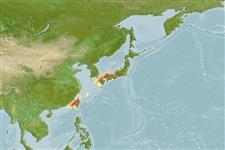>
Eupercaria/misc (Various families in series Eupercaria) >
Sillaginidae (Smelt-whitings)
Etymology: Sillago: From a locality in Australia .
More on author: Gill.
Environment: milieu / climate zone / depth range / distribution range
Ecologia
marino; salmastro demersale; non migratori; distribuzione batimetrica 0 - 30 m (Ref. 6205). Subtropical; 37°N - 21°N, 117°E - 142°E (Ref. 6205)
Northwest Pacific: southern Japan and Taiwan.
Size / Peso / Age
Maturity: Lm ? range ? - ? cm
Max length : 30.0 cm SL maschio/sesso non determinato; (Ref. 6205)
Spine dorsali (totale): 13 - 14; Raggi dorsali molli (totale): 20-22; Spine anali 2; Raggi anali molli: 22 - 24; Vertebre: 39 - 40. Swim bladder with two posterior extensions. Body is pale brown to dull brown above, lighter below; a faint mid-lateral stripe usually present; dorsal fins dusky terminally with five or six rows of dusky spots on second dorsal fin membranes, other fins hyaline.
Found in tidal flats in the estuary zone near large rivers. Oviparous (Ref. 205). Fishery is declining possibly due to habitat alteration by reclamation and pollution. The flesh is firm and well accepted in Japan (Ref. 6205).
Life cycle and mating behavior
Maturità | Riproduzione | Deposizione | Uova | Fecundity | Larve
McKay, R.J., 1992. FAO Species Catalogue. Vol. 14. Sillaginid fishes of the world (family Sillaginidae). An annotated and illustrated catalogue of the sillago, smelt or Indo-Pacific whiting species known to date. Rome: FAO. FAO Fish. Synop. 125(14):87p. (Ref. 6205)
IUCN Red List Status (Ref. 130435)
Endangered (EN) (B1ab(i,ii,iii,iv,v)+2ab(i,ii,iii,iv,v)); Date assessed: 08 December 2017
Threat to humans
Harmless
Human uses
Pesca: commerciale; Acquacoltura: probabile utilizzo futuro
Informazioni ulteriori
BibliografiaAcquacolturaProfilo di acquacolturaVarietàGeneticaElectrophoresesEreditarietàMalattieElaborazioneNutrientsMass conversion
CollaboratoriImmaginiStamps, Coins Misc.SuoniCiguateraVelocitàModalità di nuotoArea branchialeOtolithsCervelliVista
Strumenti
Special reports
Download XML
Fonti Internet
Estimates based on models
Preferred temperature (Ref.
123201): 17.7 - 24.6, mean 21.4 °C (based on 193 cells).
Phylogenetic diversity index (Ref.
82804): PD
50 = 0.5000 [Uniqueness, from 0.5 = low to 2.0 = high].
Bayesian length-weight: a=0.00575 (0.00272 - 0.01217), b=3.06 (2.89 - 3.23), in cm total length, based on LWR estimates for this Genus-body shape (Ref.
93245).
Trophic level (Ref.
69278): 3.4 ±0.44 se; based on food items.
Resilienza (Ref.
120179): Alto, tempo minimo di raddoppiamento della popolazione meno di 15 mesi (Preliminary K or Fecundity.).
Fishing Vulnerability (Ref.
59153): Low to moderate vulnerability (27 of 100).
